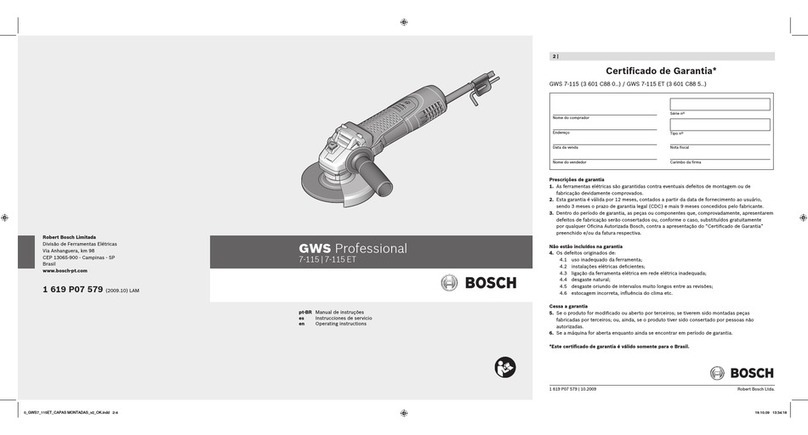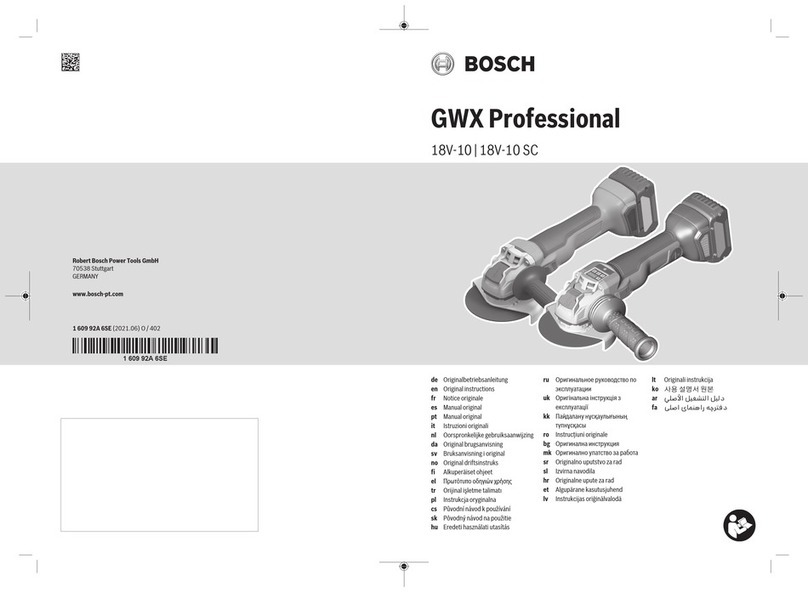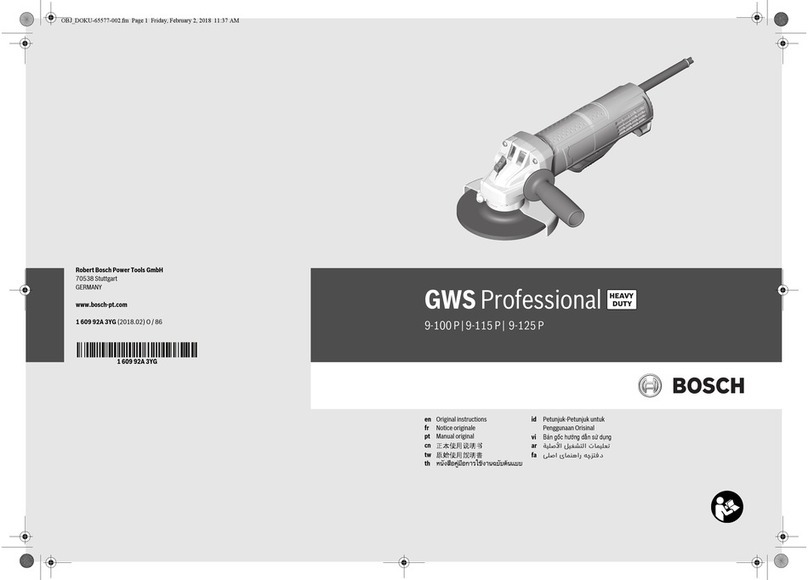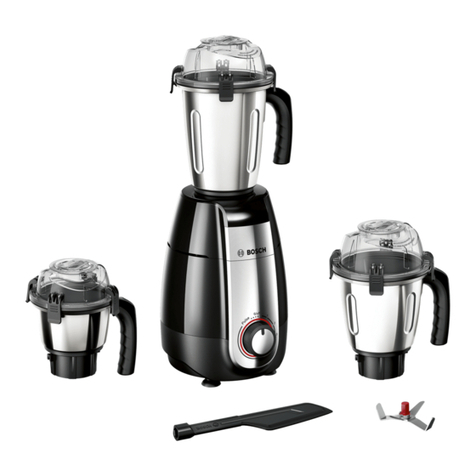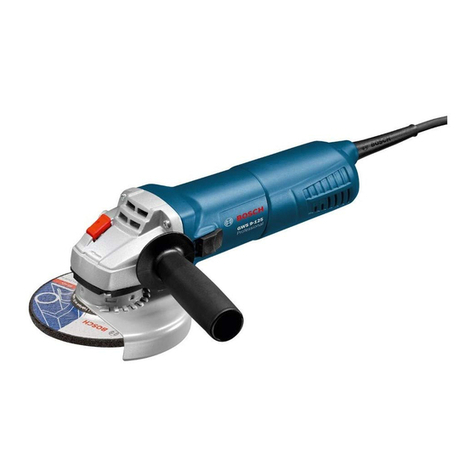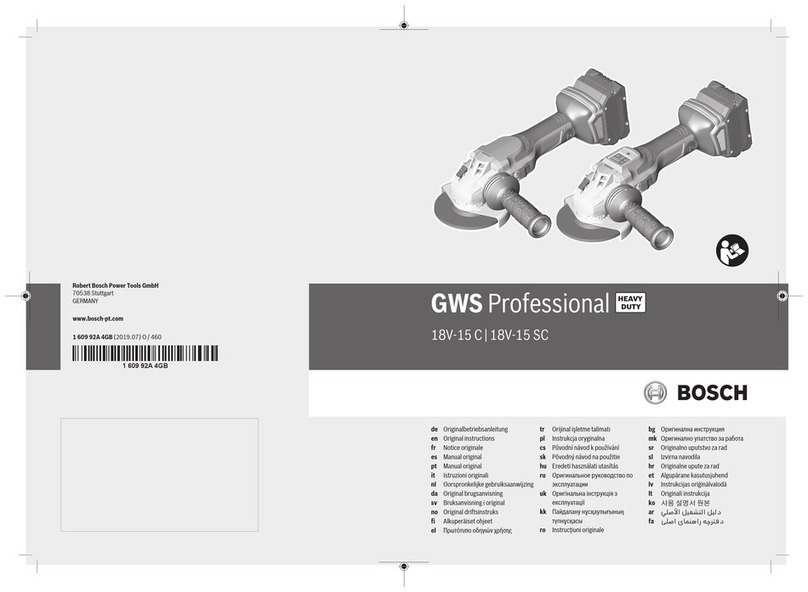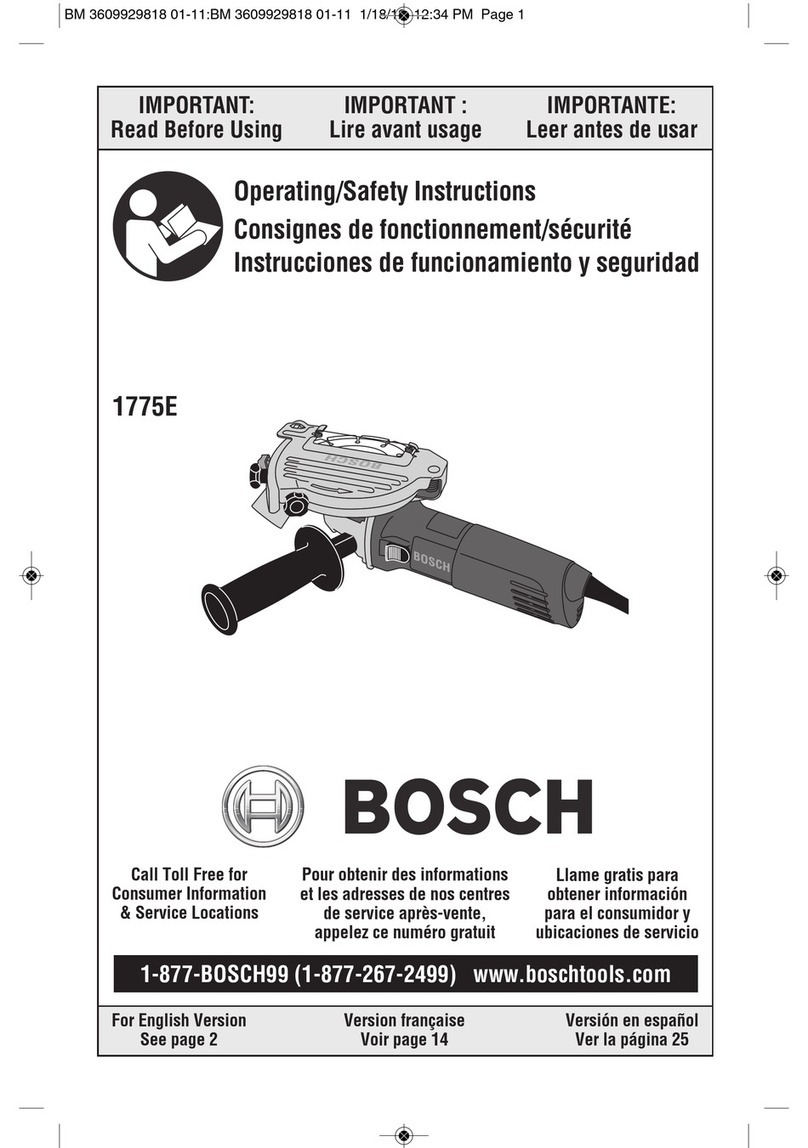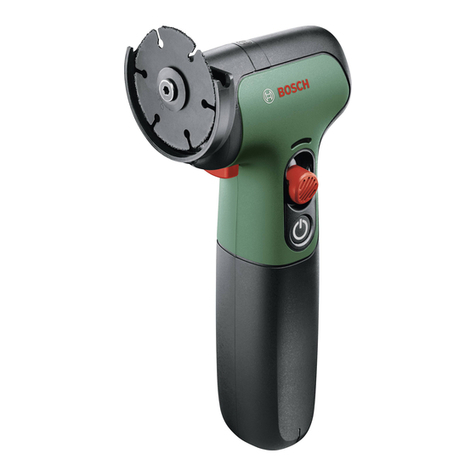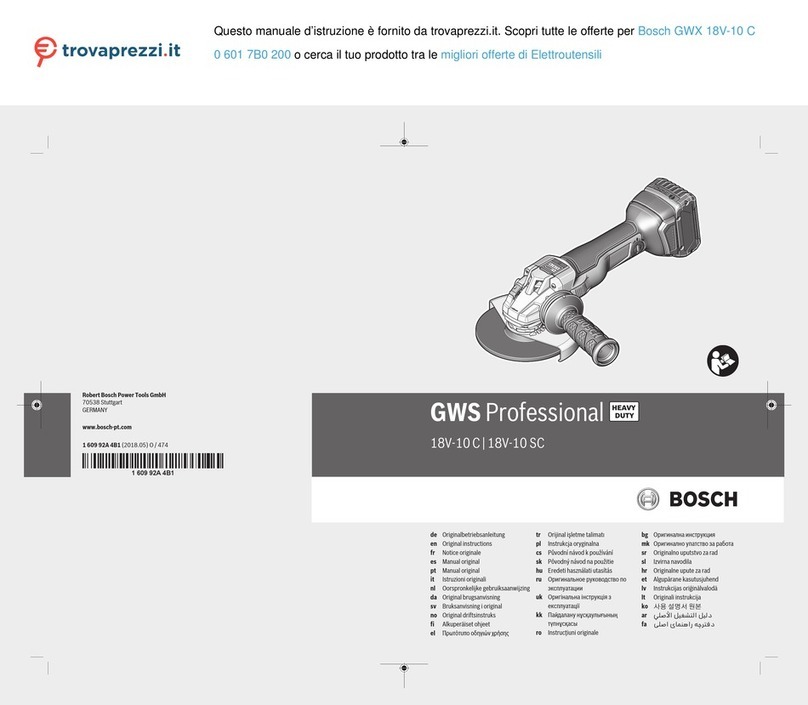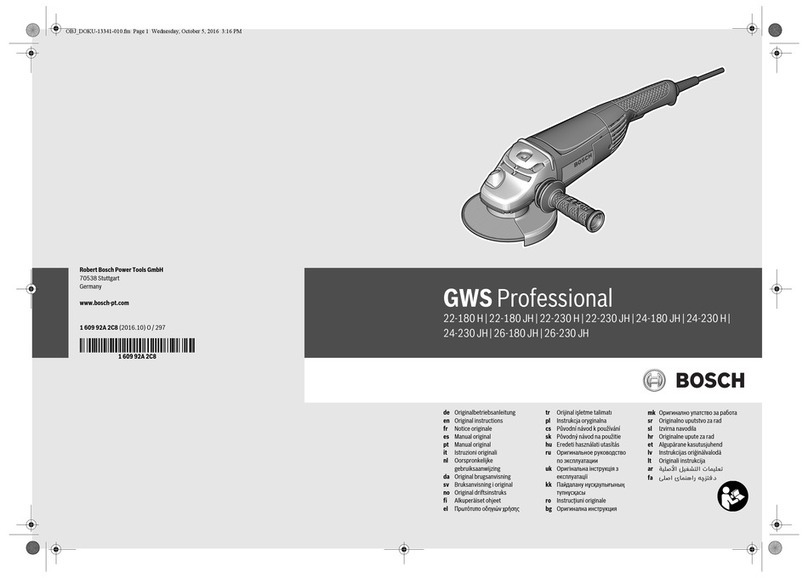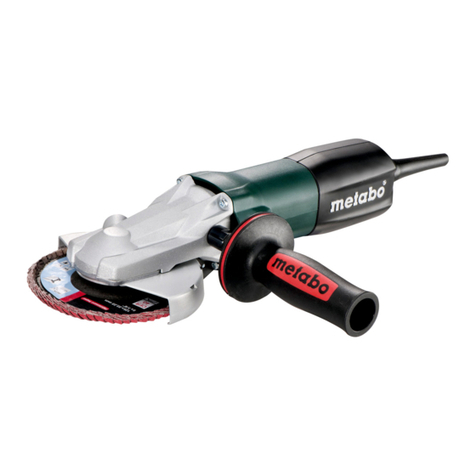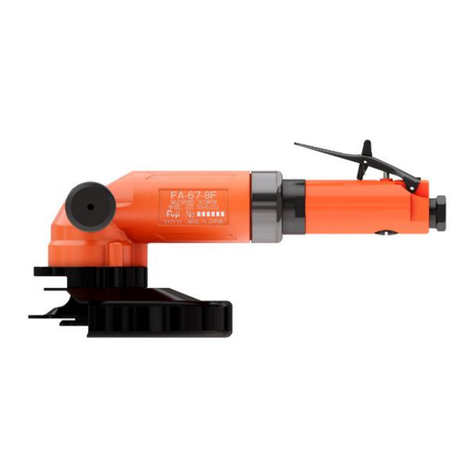English | 17
Bosch Power Tools 1 609 92A 1GK | (15.6.15)
broken accessory may fly away and cause injury beyond
immediate area of operation.
Hold the power tool by insulated gripping surfaces on-
ly, when performing an operation where the cutting ac-
cessory may contact hidden wiring or itsown cord. Cut-
ting accessory contacting a “live” wire may make exposed
metal parts of the power tool “live” and could give the op-
erator an electric shock.
Position the cord clear of thespinning accessory.Ifyou
losecontrol,thecord may becut orsnaggedand yourhand
or arm may be pulled into the spinning wheel.
Never lay the power tool down until the accessory has
come to a complete stop. The spinning wheel may grab
the surface and pull the power tool out of your control.
Do not run the power tool while carrying it at yourside.
Accidentalcontact with the spinning accessorycould snag
your clothing, pulling the accessory into your body.
Regularly clean the power tool’s air vents. The motor’s
fan will draw the dust inside the housing and excessive ac-
cumulation of powdered metal may cause electrical haz-
ards.
Do not operate the power tool near flammable materi-
als. Sparks could ignite these materials.
Do not use accessories that require liquid coolants. Us-
ing water or other liquid coolants may result in electrocu-
tion or shock.
Kickback and related warnings
Kickback is a sudden reaction to a pinched or snagged ro-
tating wheel, backing pad, brush or any other accessory.
Pinching or snagging causes rapid stalling of the rotating
accessory which in turn causes the uncontrolled power
tool to be forced in the direction opposite of the accesso-
ry’s rotation at the point of the binding.
Forexample,if an abrasive wheel is snagged orpinchedby
the workpiece, the edge of the wheel that is entering into
the pinch point can dig into the surface of the material
causing the wheel to climb out or kick out. The wheel may
either jump toward or away from the operator, depending
on direction of the wheel’s movement at the point of pinch-
ing. Abrasive wheels may also break under these condi-
tions.
Kickback is the result of power tool misuse and/or incor-
rect operating procedures or conditions and can be avoid-
ed by taking proper precautions as given below.
Maintaina firmgriponthepowertoolandpositionyour
body and arm to allow you to resist kickback forces. Al-
ways use auxiliary handle, if provided, for maximum
control over kickback or torque reaction during
start-up. The operator can control torque reactions or
kickback forces, if proper precautions are taken.
Never place your hand near the rotating accessory. Ac-
cessory may kickback over your hand.
Do not position your body in the area where power tool
will move if kickback occurs. Kickback will propel the
tool in direction opposite to the wheel’s movement at the
point of snagging.
Use special care when working corners, sharp edges,
etc. Avoid bouncing and snagging the accessory. Cor-
ners,sharpedges orbouncinghave a tendencytosnag the
rotating accessory and cause loss of control or kickback.
Do not attach a saw chain woodcarving blade or
toothedsaw blade. Suchbladescreate frequent kickback
and loss of control.
Safety warnings specific for Grinding and Abrasive Cut-
ting-Off operations
Use only wheel types that are recommended for your
power tool and the specific guard designed for the se-
lectedwheel.Wheelsfor which the power toolwasnot de-
signed cannot be adequately guarded and are unsafe.
The grinding surface of the centre depressed wheels
must be mounted below the plane of the guard lip. An
improperlymounted wheelthatprojectsthrough theplane
of the guard lip cannot be adequately protected.
The guard must be securely attached to the power tool
and positioned for maximum safety, so the least
amount of wheel is exposed towards the operator. The
guard helps to protect operator from broken wheel frag-
ments, accidental contact with wheeland sparks that
could ignite clothing.
Wheels must be used only for recommended applica-
tions. For example: do not grind with the side of the
cut-off wheel. Abrasive cut-off wheels are intended for
peripheral grinding; side forces applied to these wheels
may cause them to shatter.
Always use undamaged wheel flanges that are of cor-
rect size and shape for your selected wheel. Proper
wheel flanges support the wheel thus reducing the possi-
bility of wheel breakage. Flanges for cut-off wheels may be
different from grinding wheel flanges.
Do not use worn down reinforced wheels from larger
power tools. Wheels intended for larger power tools are
not suitable for the higher speed of a smaller tool and may
burst.
Additional safety warnings specific for abrasive cutting
off operations
Do not “jam” the cut-off wheel or apply excessive pres-
sure.Donot attempttomakeanexcessive depthofcut.
Overstressing the wheel increases the loading and suscep-
tibility to twisting or binding ofthe wheel in the cut and the
possibility of kickback or wheel breakage.
Do not position your body in line with and behind the
rotatingwheel.Whenthewheel,atthepointofoperation,
is moving away from your body, the possible kickback may
propel the spinning wheel and the power tool directly at
you.
When wheel is binding or when interrupting a cut for
any reason, switch off the power tool and hold the pow-
er tool motionless until the wheel comes to a complete
stop. Never attempt to remove the cut-off wheel from
thecut while thewheelis inmotionotherwise kickback
may occur. Investigate and take corrective action to elimi-
nate the cause of wheel binding.
OBJ_BUCH-2397-003.book Page 17 Monday, June 15, 2015 2:13 PM



